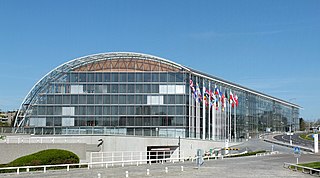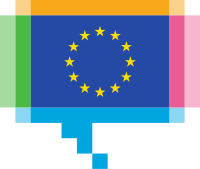
The European Investment Bank (EIB) is the European Union's development bank and is owned by the EU Member States. It is one of the largest supranational lenders in the world. The EIB finances and invests both through equity and debt solutions projects that achieve the policy aims of the European Union through loans, guarantees and technical assistance.

The Official Journal of the European Union is the official gazette of record for the European Union (EU). It is published every working day in all of the official languages of the member states of the EU. Only legal acts published in the Official Journal are binding.

Eur-Lex is an official website of European Union law and other public documents of the European Union (EU), published in 24 official languages of the EU. The Official Journal (OJ) of the European Union is also published on EUR-Lex. Users can access EUR-Lex free of charge and also register for a free account, which offers extra features.

Comitology in the European Union refers to a process by which EU law is implemented, modified or adjusted and takes place within "comitology committees" chaired by the European Commission. The official term for the process is committee procedure. Comitology committees are part of the EU's broader system of committees that assist in the making, adoption, and implementation of EU laws.

Eurostat is a Directorate-General of the European Commission located in the Kirchberg quarter of Luxembourg City, Luxembourg. Eurostat's main responsibilities are to provide statistical information to the institutions of the European Union (EU) and to promote the harmonisation of statistical methods across its member states and candidates for accession as well as EFTA countries. The organisations in the different countries that cooperate with Eurostat are summarised under the concept of the European Statistical System.
E-procurement is the business-to-business or business-to-consumer or business-to-government purchase and sale of supplies, work, and services through the Internet as well as other information and networking systems, such as electronic data interchange and enterprise resource planning.
The European Institute of Innovation and Technology (EIT) is an independent body of the European Union with juridical personality, established in 2008 intended to strengthen Europe's ability to innovate. The EIT’s three “core pillars” of activities are: entrepreneurial education programmes and courses across Europe that transform students into entrepreneurs; business creation and acceleration services that scale ideas and budding businesses; and innovation-driven research projects that turn ideas into products by connecting partners, investors, and expertise.
Government procurement or public procurement is undertaken by the public authorities of the European Union (EU) and its member states in order to award contracts for public works and for the purchase of goods and services in accordance with principles derived from the Treaties of the European Union. Such procurement represents 13.6% of EU GDP as of 2018, and has been the subject of increasing European regulation since the 1970s because of its importance to the European single market.
Water supply and sanitation (WSS) in the European Union (EU) is the responsibility of each member state, but in the 21st century union-wide policies have come into effect. Water resources are limited and supply and sanitation systems are under pressure from urbanisation and climate change. Indeed, the stakes are high as the European Environmental Agency found that one European out of ten already suffers a situation of water scarcity and the IEA measured the energy consumption of the water sector to be equivalent to 3,5% of the electricity consumption of the EU.
Europa is the official web portal of the European Union (EU), providing information on how the EU works, related news, events, publications and links to websites of institutions, agencies and other bodies. .europa.eu is also used as a common second level domain for the websites of the EU's bodies, for instance iss.europa.eu is the address of the Institute for Security Studies.

A European Documentation Centre (EDC) is a body designated by the European Commission to collect and disseminate publications of the European Union for the purposes of research and education. There are 400 such centers in all member states of the EU. The mandate of an EDC is to receive all official EU publications, documents, contracts and electronic databases then make them available to researchers, educators, students, and interested members of the general public. The centers are also legal depositories of Acquis communautaire (EU law). Although primarily academic in nature, anyone can visit an EDC to consult official EU publications.
The Single European Railway Directive 20122012/34/EU is an EU Directive that regulates railway networks in European Union law. This recast the "First Railway Directive" or "Package" from 1991, and allows open access operations on railway lines by companies other than those that own the rail infrastructure. The legislation was extended by further directives to include cross border transit of freight.

A European Union laissez-passer is a travel document issued to civil servants and members of the institutions of the European Union. It is proof of privileges and immunities the holders enjoy. The document is valid in all countries of the European Union as well as in over 100 other countries. In 2006, the European Commission issued or renewed 2,200 laissez-passer, and other agencies may issue the document as well.
The European Legislation Identifier (ELI) ontology is a vocabulary for representing metadata about national and European Union (EU) legislation. It is designed to provide a standardized way to identify and describe the context and content of national or EU legislation, including its purpose, scope, relationships with other legislations and legal basis. This will guarantee easier identification, access, exchange and reuse of legislation for public authorities, professional users, academics and citizens. ELI paves the way for knowledge graphs, based on semantic web standards, of legal gazettes and official journals.
Before data.europa.eu, the EU Open Data Portal was the point of access to public data published by the EU institutions, agencies and other bodies. On April 21, 2021 it was consolidated to the data.europa.eu portal, together with the European Data Portal: a similar initiative aimed at the EU Member States.
On April 21, 2021 data.europa.eu was launched as a single access point for open data published by EU Institutions, national portals of EU Member states and non-member states, as well as international organisations of predominantly European scope. The portal consolidates datasets previously available via the EU Open Data Portal and the European Data Portal into a single meta-catalogue. The European Data Portal, launched in its beta version on November 16, 2015, was an initiative of the European Commission, and part of the Digital Single Market.

eIDAS is an EU regulation on electronic identification and trust services for electronic transactions in the European Single Market. It was established in EU Regulation 910/2014 of 23 July 2014 on electronic identification and repeals 1999/93/EC from 13 December 1999.
CEN/TC 434 is a technical body within the European Committee for Standardization (CEN) developing standards in the field of Electronic Invoicing.

The Capital Markets Union (CMU) is an economic policy initiative launched by the former president of the European Commission, Jean-Claude Junker in the initial exposition of his policy agenda on 15 July 2014. The main target was to create a single market for capital in the whole territory of the EU by the end of 2019. The reasoning behind the idea was to address the issue that corporate finance relies on debt (i.e. bank loans) and the fact that capital markets in Europe were not sufficiently integrated so as to protect the EU and especially the Eurozone from future crisis. The Five Presidents Report of June 2015 proposed the CMU in order to complement the Banking union of the European Union and eventually finish the Economic and Monetary Union (EMU) project. The CMU is supposed to attract 2000 billion dollars more on the European capital markets, on the long-term.








